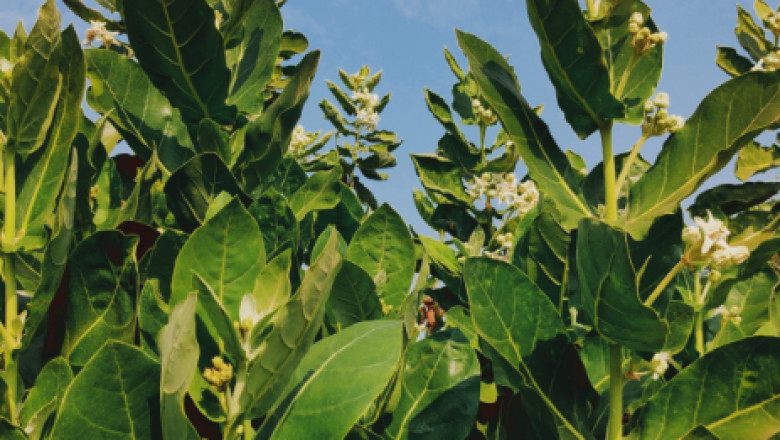views
Introduction to Giant Milkweed
The giant milkweed tree is an intriguing plant known for its sizeable, appealing foliage and graceful flowers. This plant stands out not only for its visual charm but also for its ecological importance, particularly in attracting and supporting pollinators such as butterflies. Its resilience makes it a fantastic choice for gardeners looking to add both beauty and function to their outdoor spaces. The giant milkweed tree offers a unique blend of aesthetic appeal and environmental benefits, making it a valuable addition to any garden.
Ideal Growing Conditions
To provide the best environment for your giant milkweed, consider its climate and soil needs. This plant flourishes in warm regions and does well in USDA hardiness zones 9 through 11, where moderate to high temperatures are the norm. In terms of soil, well-drained, sandy types are preferable. To boost fertility and improve drainage, mix in organic matter like compost. Position your milkweed tree in a sunny location, as it requires plenty of light for optimal growth. If you have a spot that gets full sun for most of the day, that’s ideal. Proper spacing is also crucial; ensure there’s enough room for air circulation around each plant to prevent fungal issues.
Planting Giant Milkweed
Planting giant milkweed begins with choosing between seeds and cuttings. For seeds, start by soaking them in water for 24 hours to promote germination. Once soaked, plant the seeds approximately a quarter inch deep in well-prepared soil, ensuring ample space of 3 to 4 feet apart to accommodate future growth. If you prefer using cuttings, select a healthy branch and cut a 6-inch section. Remove the leaves from the bottom half and plant the cutting directly into the soil.
Whether you use seeds or cuttings, the planting site should be well-drained and receive plenty of sunlight. Adding compost to the soil will enhance fertility and improve drainage, giving your milkweed tree a strong start. Proper spacing is essential to ensure good air circulation, which helps prevent fungal problems and promotes overall plant health. After planting, water thoroughly to help the roots establish.
Maintaining the correct soil moisture is important in the early stages. Keep the soil consistently moist but avoid waterlogging. Initial growth may be slow, but with proper care, your giant milkweed will soon establish itself and begin to thrive. Regular monitoring and adjusting care as needed will help ensure your milkweed tree grows robustly.
Care and Maintenance
Consistent care is essential for your giant milkweed tree's development. Watering should be done regularly, ensuring the soil remains moist without becoming waterlogged. Typically, watering once a week suffices, but adjust based on weather conditions, increasing frequency during hotter periods.
Pruning plays a crucial role in maintaining plant health and aesthetics. Focus on trimming dead or diseased branches to prevent the spread of potential issues. Additionally, shaping the tree through selective pruning encourages robust growth and a well-balanced form.
Fertilization is another key aspect of care. Using a balanced, slow-release fertilizer in the growing season can promote healthy growth and flowering. Apply it according to the manufacturer’s instructions, taking care not to over-fertilize, which can harm the plant.
Mulching around the base of the tree helps retain soil moisture and regulate temperature. A layer of organic mulch, such as wood chips or straw, can also suppress weed growth, reducing competition for nutrients and water.
Monitor for any signs of stress or disease, such as yellowing leaves or stunted growth. Early detection and intervention can prevent minor issues from escalating. Remove any fallen debris from around the plant to minimize the risk of fungal infections and other problems.
By paying close attention to these care practices, your giant milkweed tree will flourish, adding beauty and ecological value to your garden.
Pest and Disease Management
Regular monitoring is essential for keeping your giant milkweed tree free from pests and diseases. Common pests like aphids and spider mites can be effectively managed with periodic checks and the use of insecticidal soap when necessary. Ensuring proper air circulation around the plant is key to preventing fungal issues. Be mindful not to overwater, as this can create an environment conducive to diseases. Additionally, maintaining soil fertility through proper fertilization helps bolster the plant’s natural defenses against various threats. Clean up any fallen leaves or debris around the plant base to minimize the risk of fungal infections. By staying vigilant and taking prompt action when needed, you can keep your giant milkweed tree healthy and thriving.
Harvesting and Uses
Harvesting the giant milkweed tree at the right time is crucial for obtaining viable seeds. The best period to collect seeds is when the seed pods start to open, but haven't fully dispersed. Carefully gather the pods and store them in a dry, cool place until you're ready to plant.
Aside from seed collection, the giant milkweed tree has several other uses. Its sturdy fibers have been traditionally utilized for making ropes and textiles due to their durability and strength. These fibers can be extracted and processed for various crafting projects, offering a sustainable and eco-friendly material option.
The flowers and leaves of the giant milkweed tree can also be used in floral arrangements, adding an exotic and natural touch to your home decor. Their unique appearance makes them a popular choice among florists and DIY enthusiasts alike.
Additionally, the sap of the giant milkweed tree has been employed in traditional medicine for its purported healing properties. However, it's important to handle the sap with care, as it can be toxic if ingested or if it comes into contact with skin. Always wear gloves when handling the plant and avoid direct contact with the sap.
By exploring these various uses, you can make the most out of your giant milkweed tree, leveraging its aesthetic and practical benefits to enhance your garden and home.














Comments
0 comment